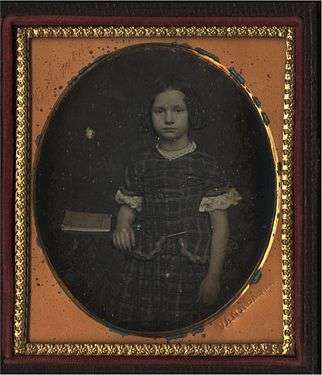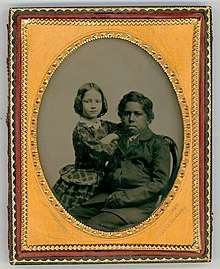Mary Mildred Williams
Mary Mildred Williams (née Botts, born 1847), was an American mixed-race child born into slavery who became a symbol used by abolitionists before the Civil War to advance the cause of ending slavery in the U.S.


Early life
Mary Mildred Williams, born in 1847, was the second child of Seth Botts, an enslaved man who was the son of his master, and his wife Elizabeth. Seth and Elizabeth were married in the early 1840s.[1]
At age seven in 1855 she became free through the efforts of her father, an escaped slave. Botts had escaped bondage in 1850, renamed himself to Henry Williams, and spent the subsequent four years seeking out the help of prominent abolitionists in Boston in his quest to secure his family’s freedom.[2] Williams, with the help of his wealthy backers, bought the property from Cornwell and ended his family’s bondage. This is how Henry’s daughter, Mary Mildred Williams, came to the attention of abolitionist Senator Charles Sumner.[2]
Relationship to the abolitionist movement
Her photograph was published, and she accompanied Senator Charles Sumner, a leading abolitionist, on a publicity tour. The photo and tour made her famous, and she was considered a real-life Ida May, the child hero of the then popular novel about a white girl kidnapped into slavery, Ida May: a Story of Things Actual and Possible by Mary Hayden Pike (1854). Mary's appearance was that of a white child, and abolitionists emphasized that fact to enlist sympathy, as well as to frighten Northerners that any child, regardless of appearance, might be snatched away and made a slave.
Articles were published about her in the Boston Telegraph and the New York Times, and copies of her photograph were widely publicized.[3][4][5] On May 19 and 20, 1856, Sumner spoke in the Senate comparing Southern political positions to the sexual exploitation of slaves then taking place in the South. Two days later Sumner was beaten almost to death on the floor of the Senate in the Capitol by Representative Preston Brooks from South Carolina, known as a hothead.[5]
See also
References
- Morgan-Owens, Jessie (2019). "The Enslaved Girl Who Became America's First Poster Child". Smithsonian Magazine. Retrieved 2020-06-19.
- Cohen, Joanna (2020). "Seeing Worth and Worth Seeing: Capitalism, Race, and Visual Culture in Nineteenth-Century America". Reviews in American History. 48: 27–35 – via Project MUSE.
- "A White Slave from Virginia". New York Times. March 9, 1855. Retrieved July 5, 2016.
- Gage, Joan. "A White Slave Girl "Mulatto Raised by Charles Sumner"". Mirror of Race. Retrieved July 5, 2016.
- Morgan-Owens, Jessie (February 19, 2015). "Poster Child: There's Something About Mary". Massachusetts Historical Society. Retrieved July 6, 2016.
External links
- Ida May: A Story of Things Actual and Possible Published 1854